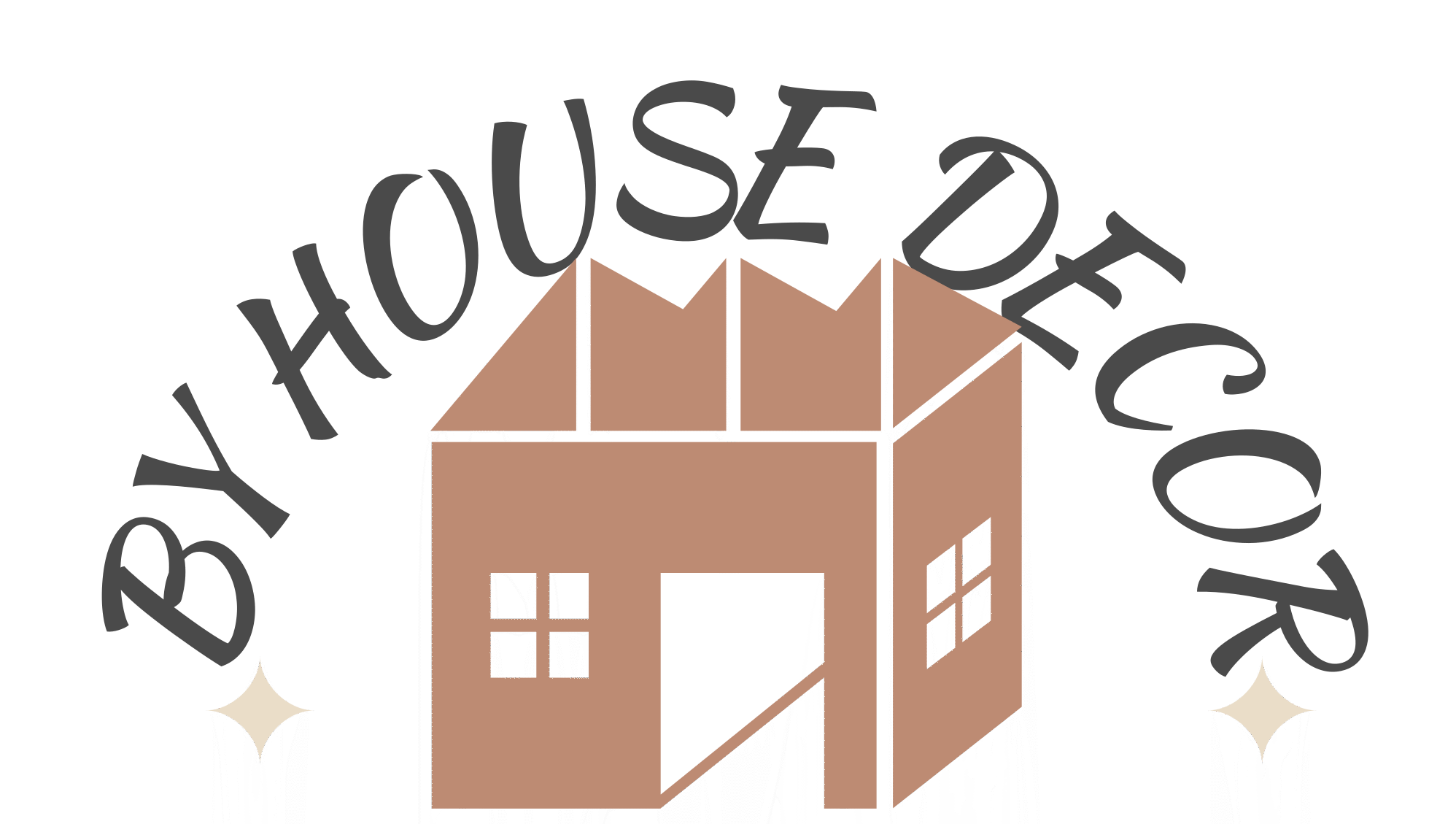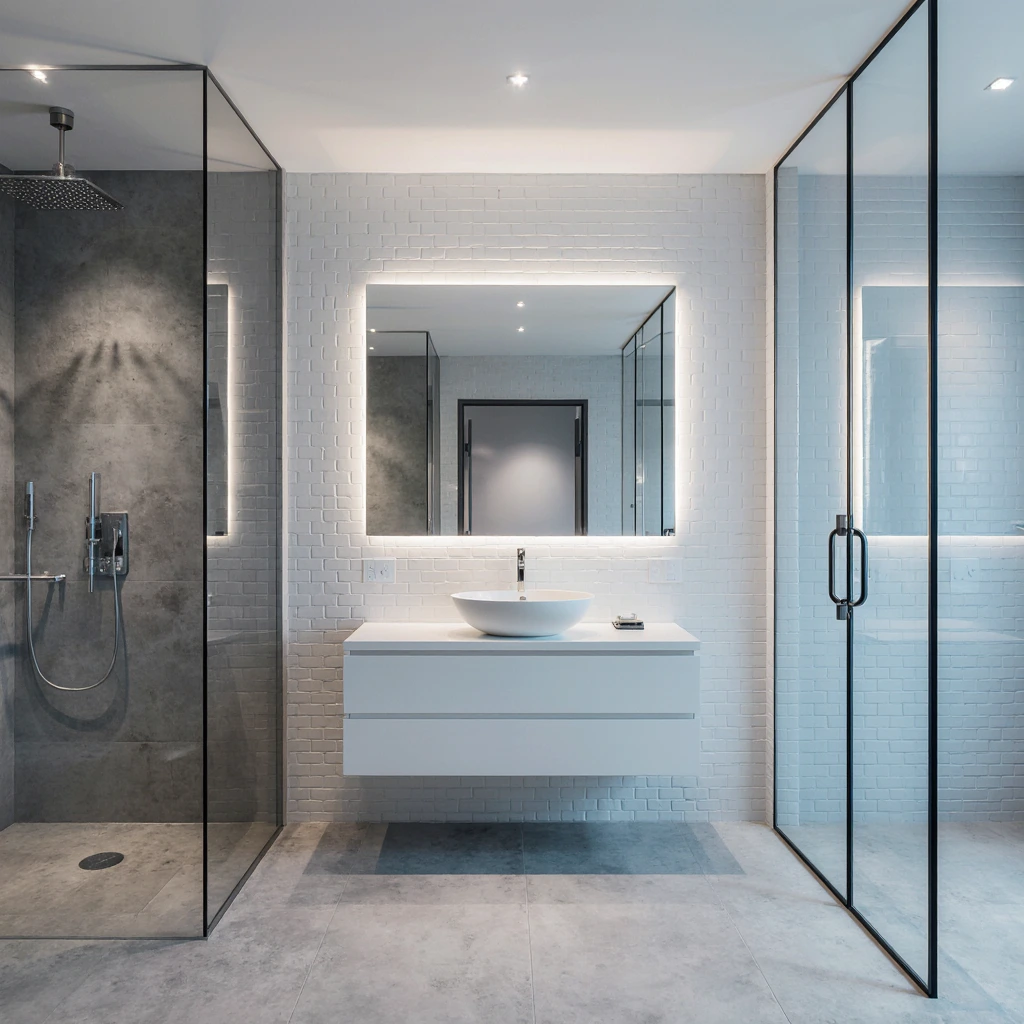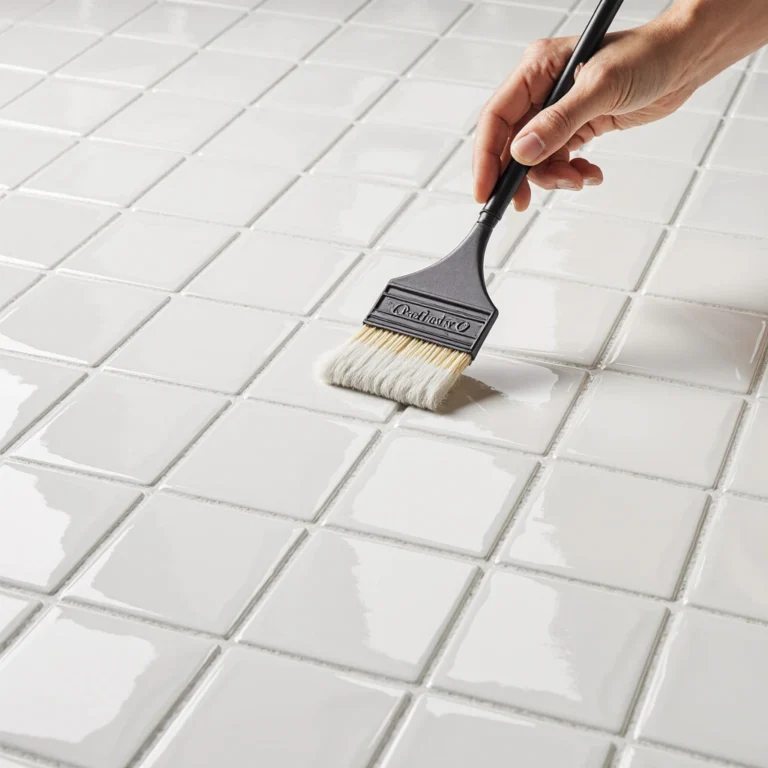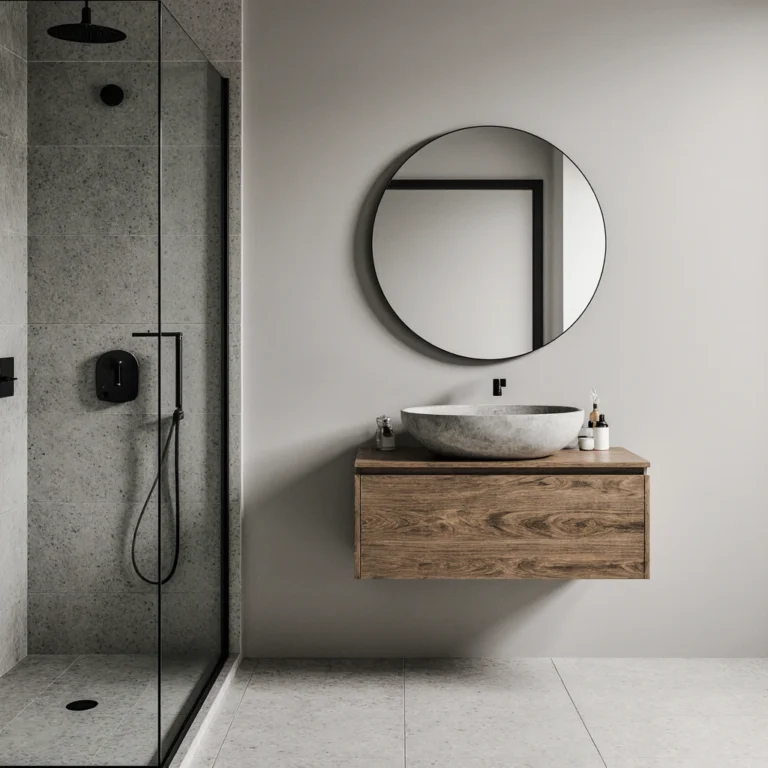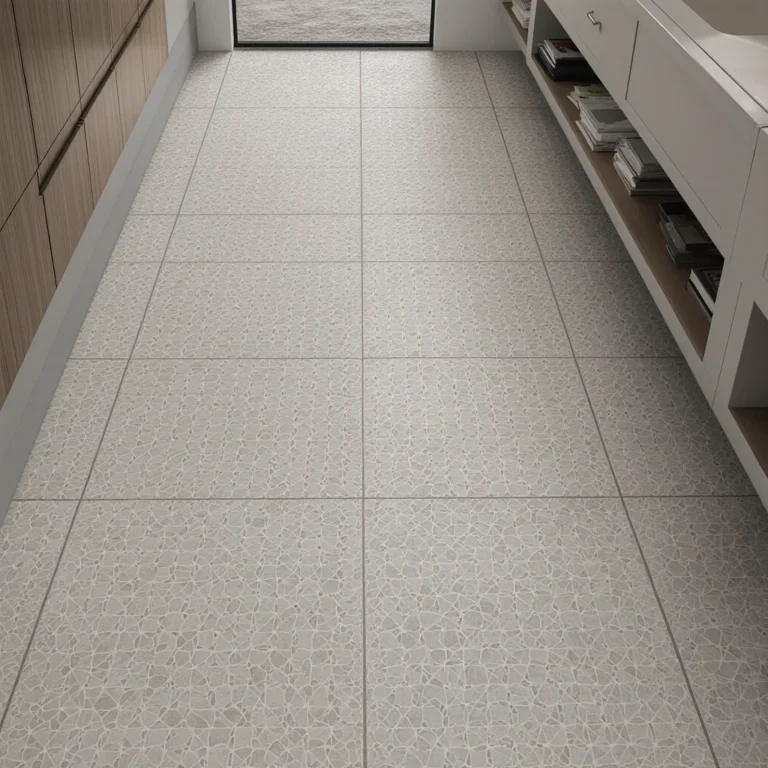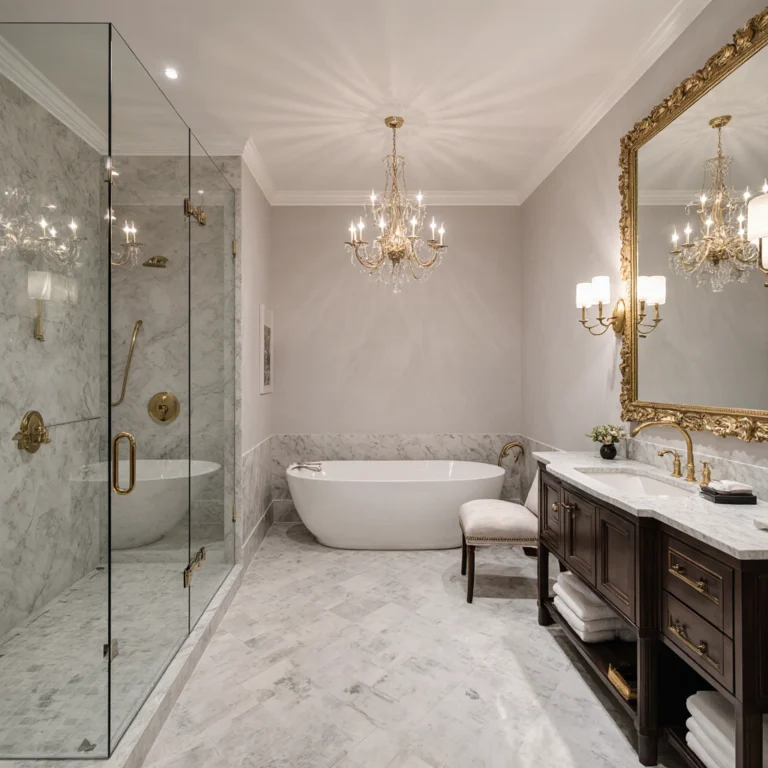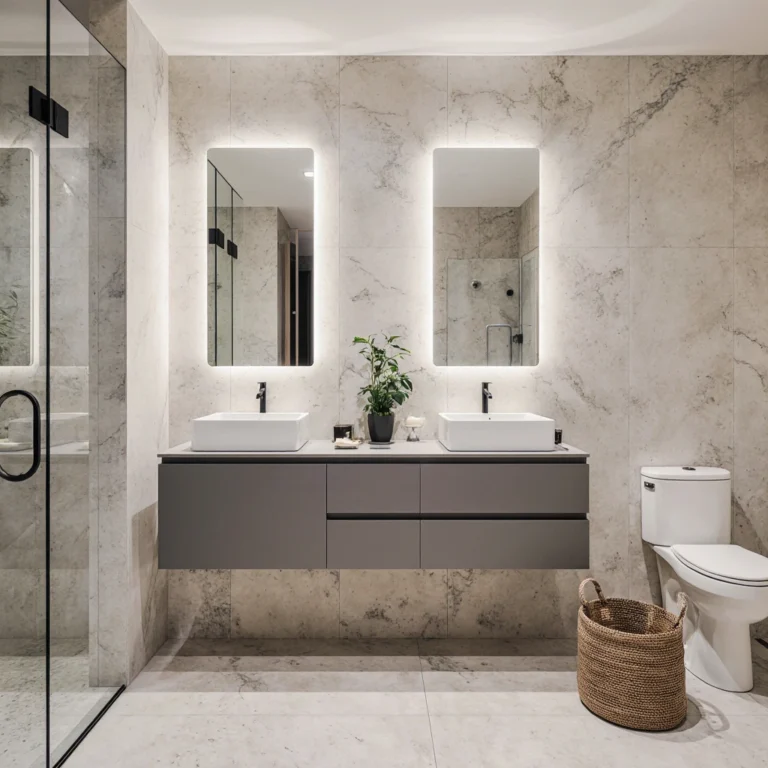Transform Your Basement: 25 Brilliant Basement Bathroom Ideas That Maximize Space and Style
Table of Contents
Creating a functional and beautiful basement bathroom ideas presents unique opportunities and challenges that transform your basement into a valuable living space. Whether you’re finishing your basement for the first time or renovating an existing space, clever basement bathroom ideas add significant value to your home while providing essential functionality for family members and guests.
Basement bathrooms serve multiple purposes beyond basic needs. They’re ideal for entertaining guests, accommodating teens’ privacy needs, hosting older family members, or creating income-generating rental units. With proper planning and creative design solutions, a basement bathroom can become a stunning focal point that rivals any upstairs facility.
Understanding Basement Bathroom Design Basics
Effective Solutions for Small Spaces
When working with limited space, every inch counts in basement bathroom design. The key is to maximize vertical space and choose fixtures that serve multiple purposes.
Compact Design Strategies:
- Corner fixtures save valuable floor space while maintaining full functionality.
- Wall-mounted toilets create the illusion of more space and simplify cleaning.
- Sliding barn doors eliminate the need for additional counter space, a common feature of traditional doors.
- Pocket doors disappear into the walls when opened, maximizing usable space.
- Shower and bathtub combinations offer dual functionality without sacrificing comfort.
Visual Tricks to Expand Space:
- Light-colored walls and fixtures reflect available light, making spaces appear larger.
- Large, strategically placed mirrors double the visual space.
- Glass shower enclosures maintain sight lines and eliminate visual obstructions.
- Floating bathtubs create a clear view of the floor space, enhancing openness.
- Vertical tile patterns draw the eye upward, highlighting the height of the ceiling.
Making the Most of Large Basement Spaces
Spacious basements offer great potential for luxurious bathrooms and creative zoning. These spaces allow for separate areas dedicated to different functions while maintaining cohesive design elements.
Incorporating Luxury Features:
- Freestanding bathtubs add a touch of elegance to large spaces.
- Separate shower and bathtub areas add a touch of comfort and luxury.
- Double sinks accommodate multiple users simultaneously.
- Dedicated makeup or grooming stations add comfort and luxury.
- Exercise or wellness areas can be incorporated into bathrooms.
Zoning Strategies for Large Spaces:
- Designate distinct areas for bathing, grooming, and storage using partial walls or decorative partitions.
- Add benches or chairs for seating for added comfort.
- Design separate restroom stalls to ensure privacy in shared spaces.
- Add dedicated washing areas when plumbing allows for efficient workflow.
Smart Storage Solutions for Basement Bathrooms
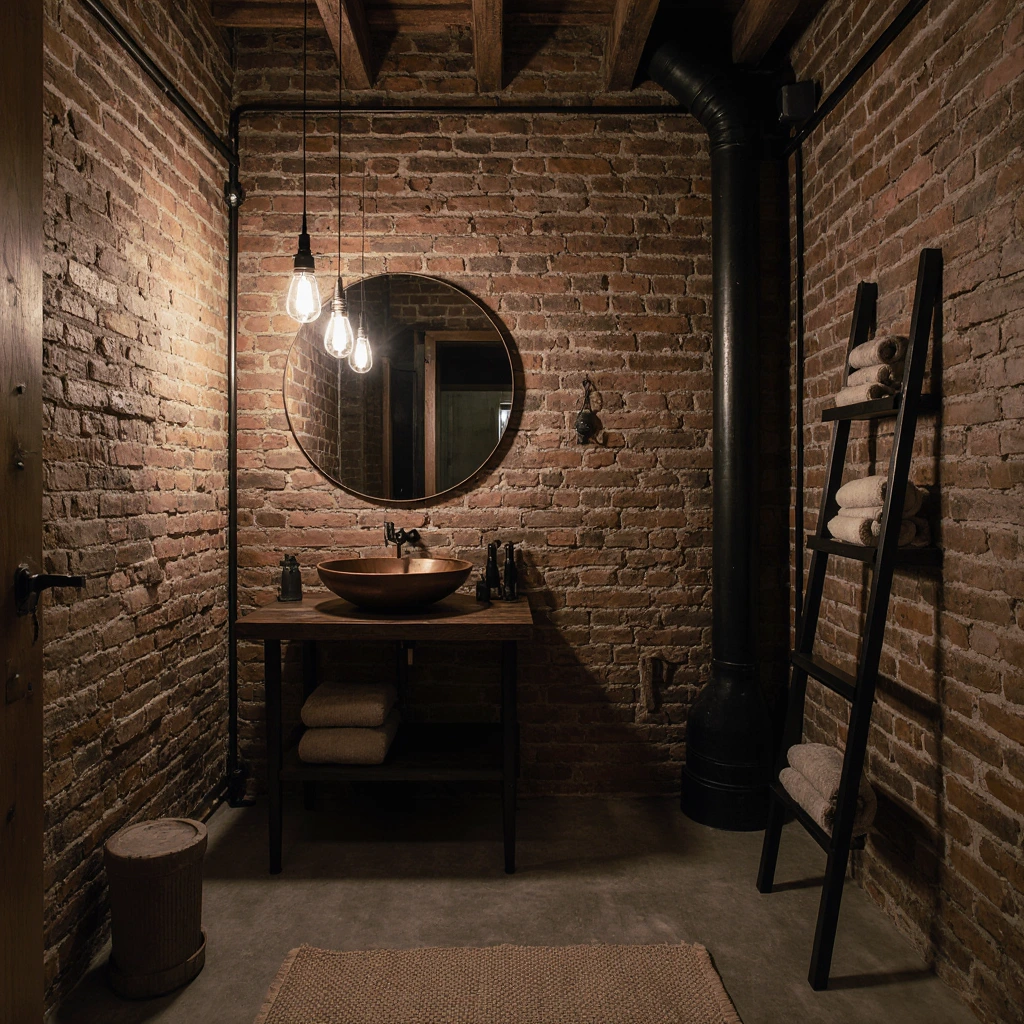
Maximizing Vertical Storage
Basement bathrooms often lack the traditional storage options found in main-floor bathrooms. Innovative vertical solutions can provide ample storage space without compromising floor space or design aesthetics.
Wall-mounted storage options:
- Floating shelves above toilets make use of often-wasted vertical space.
- Mirrored medicine cabinets efficiently double as storage.
- Towel rails provide storage space while adding rustic design touches.
- Wall cabinets keep essentials within easy reach and organized.
- Magnetic strips securely attach small metal items to the walls.
Built-in storage integration:
- Recessed niches in shower areas provide convenient product storage.
- Custom designs for bathtubs can include dedicated storage compartments.
- Under-stair storage utilizes spaces not ideal for linens and supplies.
- Built-in benches with built-in storage combine seating and organization.
Moisture-Resistant Storage Materials
Basement environments require special care for storage materials that can withstand moisture and potential moisture problems.
Recommended Storage Materials:
- Stainless steel shelving is resistant to rust and moisture.
- Plastic storage containers prevent mold growth on contents.
- Cedar wood elements naturally resist moisture and provide a fresh, fragrant scent.
- Glass containers display contents while protecting them from moisture.
- Marine finishes protect wooden storage items for the long term.
Durable and Stylish Materials for Basement Bathrooms.
Moisture-Resistant Flooring Solutions.
Basement bathroom flooring must balance elegance, comfort, and moisture resistance. Choosing the right flooring prevents long-term maintenance issues and supports your overall design vision.
Best Moisture-Resistant Flooring Options:
- Luxury vinyl planks (LVP) offer the beauty of wood with complete waterproofing.
- Ceramic and porcelain tiles offer endless design possibilities with superior durability.
- Natural stone tiles offer a luxurious look with natural moisture resistance.
- Epoxy flooring offers smooth, easy-to-clean surfaces, ideal for contemporary designs.
- Polished concrete adds a sleek, industrial aesthetic with unparalleled durability.
Installation Considerations:
- Proper subfloor preparation prevents future moisture problems.
- Radiant heating systems can be integrated under tile floors for added comfort.
- Transition strips between different flooring materials prevent water seepage.
- Proper drainage slopes direct water toward drains effectively.
Wall Finishes for High-Humidity Environments
Basement bathroom walls face unique challenges due to moisture, potential water exposure, and temperature fluctuations. Choosing the right wall finishes ensures long-lasting beauty and function.
Moisture-resistant wall options:
- Semi-gloss and satin finishes are moisture-resistant and easy to clean.
- Ceramic wall tiles provide complete waterproofing with design flexibility.
- Natural stone veneers provide a luxurious texture and moisture resistance.
- Fiberglass-reinforced concrete (FRP) panels provide high-quality durability for high-traffic areas.
- Waterproof wallpaper specifically designed for bathrooms.
Special Considerations:
- Good ventilation prevents moisture buildup behind wall finishes.
- Vapor barriers protect structural elements from moisture damage.
- Mold-resistant underlays provide additional protection under finishing materials.
Lighting and Ventilation Strategies
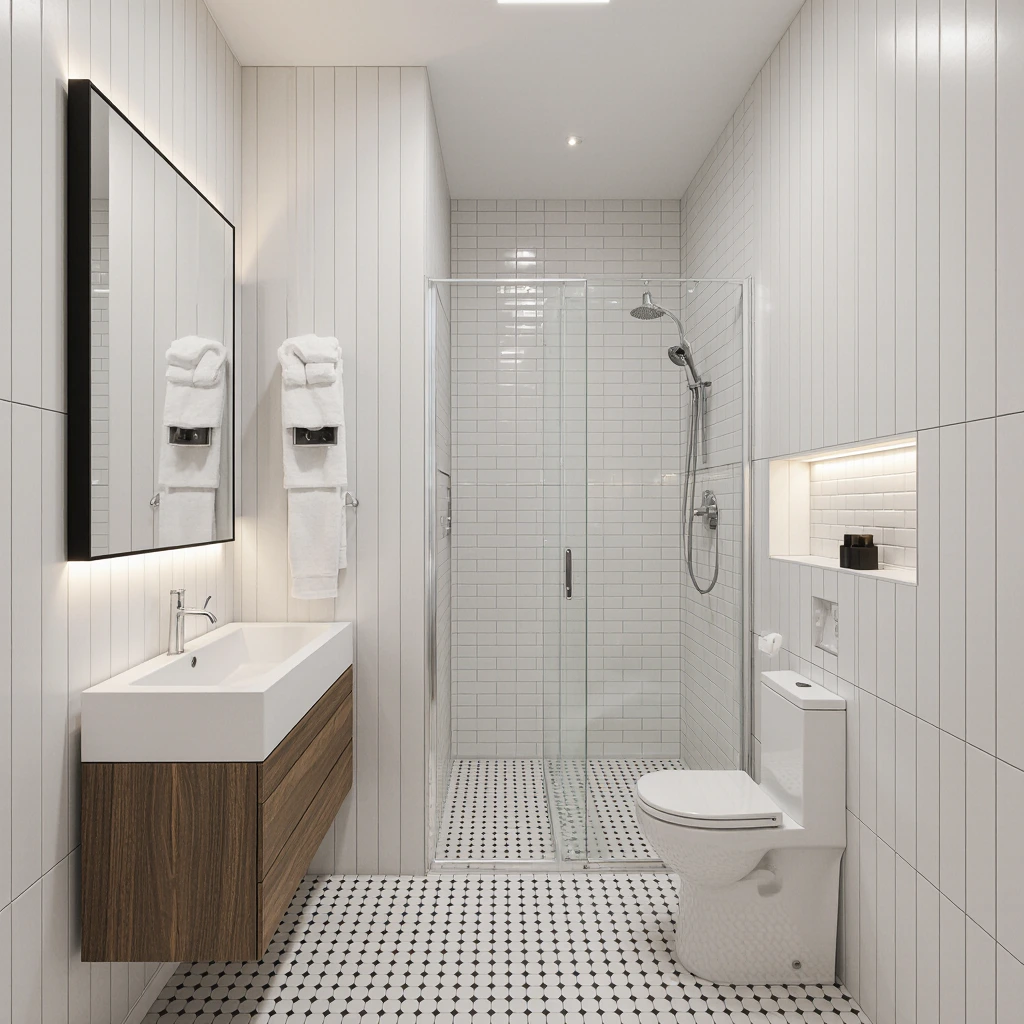
Overcoming Limited Natural Light
Most basement bathrooms lack natural light, making artificial lighting critical to their functionality and ambiance. Strategic lighting distribution can transform dark spaces into bright and welcoming environments.
Multi-layered lighting approach:
- Ambient lighting provides overall illumination through ceiling fixtures or recessed lights.
- Task lighting focuses on specific activities, such as shaving or applying makeup.
- Accent lighting highlights design features and adds aesthetic appeal.
- Mimicking natural light with full-spectrum LEDs enhances mood and functionality.
Creative lighting solutions:
- Light tubes bring natural light from above the floor into basement spaces.
- LED strip lighting beneath freestanding bathtubs creates a calming atmosphere.
- Backlit mirrors provide task lighting while also serving as distinctive design features.
- Pendant lights add a touch of elegance while providing focused illumination.
- Dimmable switches allow lighting to be adjusted to suit different activities and times.
Basic Ventilation Requirements
Good ventilation prevents moisture buildup, mold growth, and odor buildup in basement bathrooms. Efficient ventilation systems preserve your investment while maintaining healthy air quality.
Ventilation System Components:
- Exhaust fans remove moisture and odors directly from their sources.
- Integrated HVAC systems ensure good air circulation throughout the basement.
- Dehumidification systems maintain optimal humidity levels year-round.
- Fresh air extraction systems replace stale air with clean outdoor air.
Sizing and Distribution Guidelines:
- Fans should provide a minimum of 1 cubic foot per minute per square foot of bathroom space.
- Timer switches ensure adequate runtime after bathroom use.
- Multiple small fans often perform better than single, large fans.
- Placing them near shower areas traps maximum moisture at the source.
Common Basement Bathroom Design Mistakes to Avoid
Poor Moisture Management
Many basement bathroom projects fail due to inadequate planning for moisture control. Understanding and addressing moisture sources prevents costly repairs and plumbing problems.
Basic Moisture Control Elements:
- Waterproof barriers behind all wet areas prevent structural damage.
- Proper drainage slopes direct water toward drains and away from walls.
- Adequate insulation prevents condensation on cold surfaces.
- Vapor barriers protect structural elements from moisture infiltration.
Poor Utility Access Planning
Basement bathroom renovations often encounter utility access challenges that were not considered during the initial planning stages.
Utility Planning Essentials:
- Initial plumbing must accommodate proper drainage slopes and ventilation requirements.
- Electrical circuits must provide adequate power for lighting, ventilation, and vents.
- HVAC considerations include the integration of heating, cooling, and ventilation.
- Internet access and cable are provided for modern bathroom entertainment features.
Ignoring Building Code Requirements
Basement bathrooms must comply with local building codes, which may differ from those for main-floor bathrooms.
General Code Considerations:
- Minimum ceiling heights vary by region and type of use.
- Emergency exit requirements may affect window or door placement.
- Electrical outlet placement follows specific guidelines for wet areas.
- Plumbing requirements ensure proper drainage and prevent sewer gases from seeping in.
Design Inspiration for Every Taste
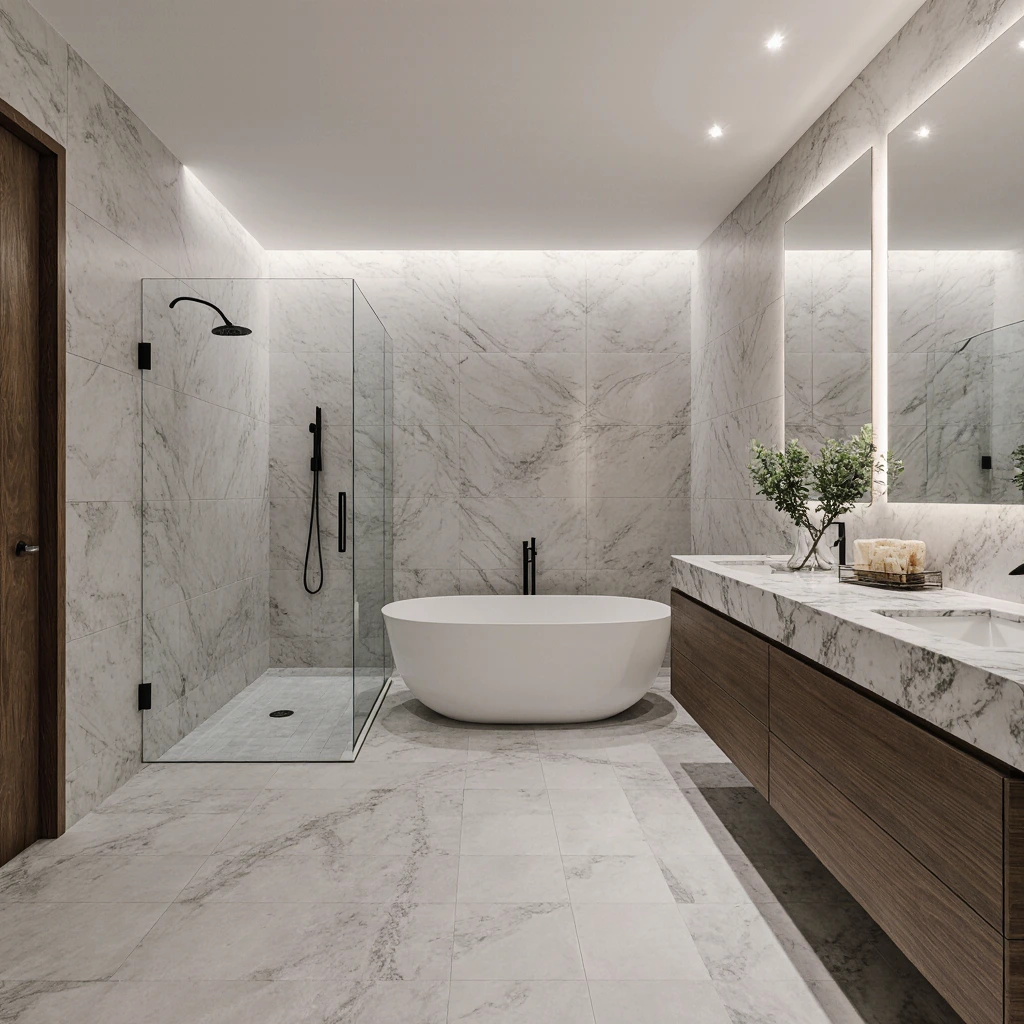
Modern Minimalist Styles
Clean lines, neutral colors, and organized spaces give modern basement bathroom designs a fresh and spacious feel, despite their underground location.
Key Modern Elements:
- Floating bathtubs with sleek geometric lines
- Large-format tiles with simple grout lines
- Frameless glass shower enclosures
- Monochromatic color schemes with strategic accent colors
- Concealed storage solutions that maintain the design aesthetic.
Rustic and Industrial Designs
Basement locations naturally fit in with rustic and industrial designs that highlight the basement atmosphere, while creating warm and inviting spaces.
Rustic Design Features:
- Exposed brick or stone walls add natural texture and warmth.
- Wood-beamed ceilings create a cozy, cabin-like atmosphere.
- Brass or bronze fixtures develop a beautiful patina over time.
- Natural stone countertops add natural beauty and durability.
** Industrial Elements:**
- Exposed plumbing and pipes become distinctive design features.
- Metal and concrete materials add a modern loft aesthetic.
- Edison bulb lighting adds vintage industrial charm.
- Black fixtures and accessories add bold contrast.
Summary and Next Steps
Transforming your basement with a thoughtful bathroom design provides valuable living space while meeting the family’s practical needs. Success depends on careful planning that considers moisture control, good ventilation, adequate lighting, and compliance with building codes. Whether you choose modern simplicity, rustic charm, or industrial chic, your basement bathroom can be a wonderful and functional addition to your home.
Are you ready to start your basement bathroom transformation? Start by consulting local contractors about structural requirements and building permits. Consider hiring professional plumbing and electrical contractors, while taking care of the aesthetic details yourself to balance cost and quality.
Act Today:
- Measure your space and create a basic floor plan
- Research local building codes and permit requirements
- Get quotes from licensed plumbers and electricians
- Start by gathering inspirational photos and material samples
- Set a realistic budget that includes allowances for unexpected problems
Share your basement bathroom dreams in the comments below, and don’t forget to subscribe for more home renovation inspiration and practical design tips!
Best Amazon Picks :
FAQs
How much does a basement bathroom typically cost?
Basement bathroom costs vary greatly depending on size, finishes, and existing infrastructure. Basic installations range from $3,000 to $8,000, while luxury renovations can cost upwards of $15,000 to $25,000. Factors affecting cost include plumbing access, necessary electrical upgrades, waterproofing requirements, and the quality of finishes.
Do I need special permits to install basement bathrooms?
Most jurisdictions require permits for basement bathrooms, especially when adding new plumbing or electrical work. Contact your local building department in the early planning stages to understand specific requirements, inspection schedules, and fee structure. Professional contractors typically handle permit applications and ensure code compliance.
How do I deal with low ceiling heights in basement bathrooms?
Standard basement ceiling heights of 7 to 8 feet are appropriate for most bathroom functions. Enhance the sense of height with vertical design elements such as tall mirrors, vertical tile patterns, and uplighting. Avoid bulky ceiling fixtures that reduce ceiling height, and instead opt for recessed or low-profile options.
What’s the best way to prevent mold and damp problems?
Prevent mold through good ventilation, waterproofing, and humidity control. Install appropriately sized exhaust fans for your space, use waterproof barriers behind wet areas, and keep humidity levels below 60%. Regular cleaning with mold-preventing products and prompt attention to any water leaks prevents most damp problems.
Can I install a bathroom in a basement without breaking the concrete?
In some cases, installing bathrooms in a basement without breaking the concrete can be done. Options include sump pumps that lift waste into the main sewer lines, above-ground plumbing systems, and soaker toilets. These solutions may be more expensive initially, but they avoid extensive concrete work and the associated costs.
